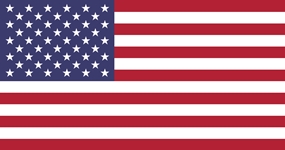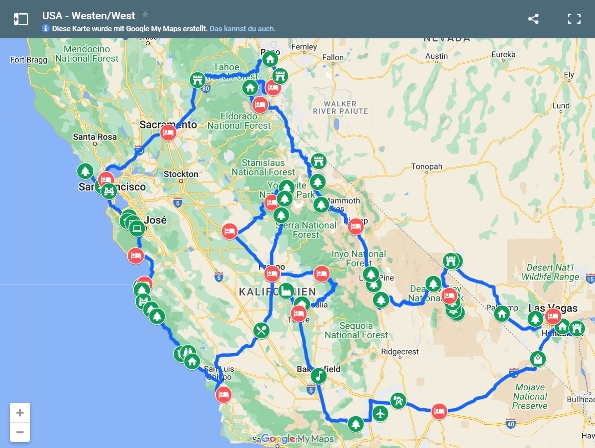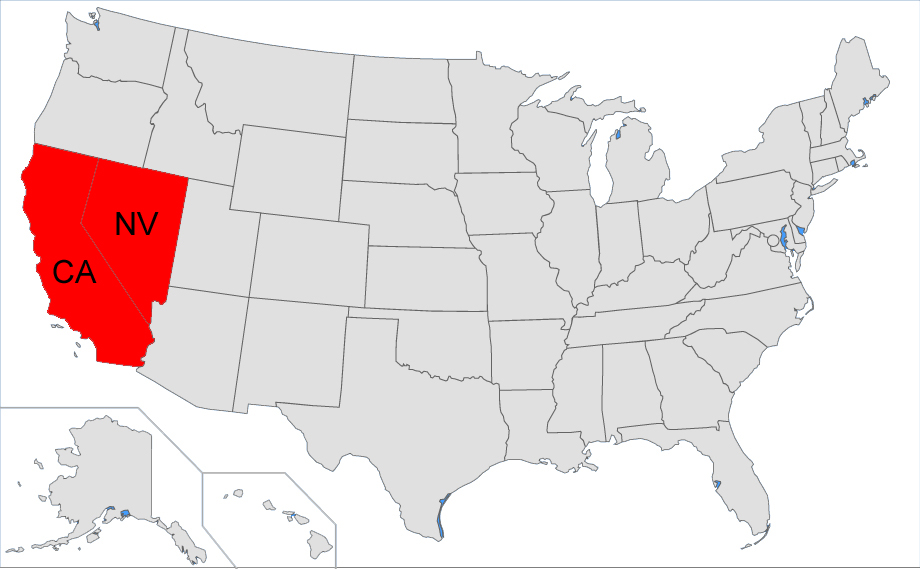California • Nevada

In the Deep West
Around the Sierra Nevada – hardly a round trip has been more diverse. Four impressive national parks, blistering heat and snow within just a few days, a completely crazy metropolis and even more crazy attractions “in the middle of nowhere” – just come along on our journey through the West of the USA.
Starting point of our trip is the gambling city of Las Vegas; hardly any place in the USA is more colorful, more glittering – somehow a huge amusement park. However, if you drive just an hour out of the city, the contrast couldn’t be greater – welcome to the desert. First stop is Red Rock Canyon with its 14-mile panorama road. Before you leave Nevada, be sure to check out Rhyolite, a ghost town decorated with colorful artwork. Then it’s down over Daylight Pass into Death Valley – even in May 40 degrees Celsius is not uncommon.
After two days in the park, we follow the Sierra Nevada on the east side into Owens Valley. The Alabama Hills are famous for their bizarre granite cliffs and are the backdrop for dozens of movies. The Manzanar War Relocation Center commemorates the internment of Japanese Americans during World War II. The winter resort of Mammoth Lakes is high up in the mountains; a beautiful trail leads around Horseshoe Lake. Back down in the valley is Mono Lake with its bizarre lime tuff formations and Bodie State Historic Park, another ghost town with 170 buildings.
If you want to circle Lake Tahoe on the western side, you have to go up again. On the way you pass South Lake Tahoe and Tahoe City. Next destination on this zigzag course is Carson City, the capital of Nevada. A total work of art is Virginia City, a former mining town that is completely protected as a historic monument. Strolling through the little town is great fun. For Reno, on the other hand, according to its own statement “The biggest little city in the world”, you don’t have to plan too much time.

Cities, Nature, Art – Have a look…

Now we head west across the Sierra Nevada, the longest and highest mountain range in the USA. Our destination is Sacramento, the capital of the state of California. There is a lot to see around the state capitol and especially in Old Sacramento. Near San Rafael, the next stop on our route, there is the Muir Woods National Monument with 800-year-old sequoia trees and the Point Reyes National Seashore, a bird paradise right on the Pacific.
On US 101 we roll over what is probably the most famous bridge in the world, the Golden Gate Bridge. However, this time we skip San Francisco; instead, we drive directly to Silicon Valley and visit the headquarters of Facebook, Google and Apple as well as the renowned Stanford University.
Beyond Santa Cruz begins the 17 Mile Drive. The toll road starts in Monterey and ends in Carmel-By-The-Sea. We follow US 1 along Big Sur, a coastal section of approximately 100 km. The Bixby Creek Bridge is impressive, framed by some state parks. The Piedras Blancas Elephant Seal Rookery is an absolute highlight. Depending on the season, up to 15.000 (!) elephant seals lie close together on the beach. It’s an incredible spectacle! What follows is Hearst Castle, the fairytale castle of former newspaper tycoon William Randolph Hearst. As a touristic counterpoint to the hype about Hearst Castle follows Nit Wit Ridge, an enchanted house built from all kinds of waste materials.
At Arroyo Grande we leave the coast and head again for the Sierra Nevada. The destination are the three national parks Yosemite, Kings Canyon and Sequoia, where we will spend the next four days. In order to close the circle, we follow the southern part of the Sierra Nevada; anyone interested in raisins can visit the Sun-Maid raisin factory in Kingsburg. Bakersfield is the center of country music in the West; fans of this music style make sure to visit Buck Owens Crystal Palace.
The detour to Edwards Air Force Base is only worthwhile for aviation enthusiasts; in any case, the visitor center of the Rio Tinto Borax Mine in Boron is more exciting. Half of the world’s borax is extracted here. The last highlight on this tour is Hoover Dam, whose gigantic wall dams the Colorado River right on the border between Arizona and Nevada. The resulting Lake Mead is the largest reservoir in the United States. From here it’s only an hour’s drive back to Las Vegas.

Route Description
| Tag/Day | Von/From | Nach/To | Route |
|---|---|---|---|
| 01 | Las Vegas Airport (LAS) | Las Vegas | 005 m / 010 km |
| 02 | Las Vegas | Las Vegas | 000 m / 000 km |
| 03 | Las Vegas | Death Valley NP | 190 m / 305 km |
| 04 | Death Valley | Death Valley NP | 100 m / 160 km |
| 05 | Death Valley | Bishop | 200 m / 320 km |
| 06 | Bishop | South Lake Tahoe | 225 m / 360 km |
| 07 | South Lake Tahoe | Carson City | 070 m / 115 km |
| 08 | Carson City | Sacramento | 185 m / 300 km |
| 09 | Sacramento | San Rafael | 090 m / 145 km |
| 10 | San Rafael | Point Reyes | 100 m / 160 km |
| 11 | San Rafael | Santa Cruz | 110 m / 180 km |
| 12 | Santa Cruz | Monterey | 060 m / 095 km |
| 13 | Monterey | Arroyo Grande | 160 m / 260 km |
| 14 | Arroyo Grande | Arroyo Grande | 000 m / 000 km |
| 15 | Arroyo Grande | Merced | 210 m / 340 km |
| 16 | Merced | Yosemite National Park | 100 m / 160 km |
| 17 | Yosemite National Park | Fresno | 120 m / 190 km |
| 18 | Fresno | Kings Canyon | 100 m / 160 km |
| 19 | Kings Canyon | Tulare | 130 m / 210 km |
| 20 | Tulare | Barstow | 280 m / 450 km |
| 21 | Barstow | Boulder City | 185 m / 300 km |
| 22 | Boulder City | Las Vegas Airport (LAS) | 025 m / 040 km |
| Total | 2.645 m / 4.260 km |













































